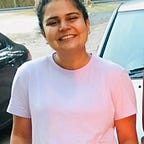Spectacles for the future. Part 2
How might we spark a conversation?
Global Trends and Changing Paradigms
To design the future, it was important for us to understand the present and that’s how we began. We did an in-depth horizon scanning for the project, to understand the topic from various perspectives. This exercise helped us collect and analyze a significant amount of data in terms of information and trends. Parallelly, we populated our future world map. As I read through reports and articles over the internet to understand the subject better, I realized that If we want to bring an effective change in the future we must change the way we think and perceive the world around us today and we need a good rational toolkit to become more successful creators of the future: and to achieve this we all should become more resilient to change.
The scanning helped us speculate some of our early future visions:
Should we have a climate risk tax to help people become more aware of their actions?
What if Carbon information was more visible to the people?
What if there were no energy retailers and people got energy directly from the grid?
What if…?
The bottom line to this exercise is we cannot work to create a future which we do not first imagine.
Research Through Design — the approach taken
In simple words Research Through Design is an approach where Designing and Researching happen on parallel grounds as both design and research activities are surprisingly similar — both aim to create something new, building on what was known before. It is the process of continuous ideation, prototyping, and testing while researching and improvising. Research through Design in umbrella terms is something built within the research process and put to use for research purposes.
As said by my tutors “Getting your hands dirty right from the start”
In the midst of all the readings, we created a map that represented the elements from our desired future. This helped us collaboratively discuss how our futures looked to align ourselves as a team.
A Dystopia in the future
After understanding the hopeful aspects of energy, we started with thinking and mapping about our future world — to find the right balance between what can be and what should be. This was quite a storming phase for us as we only concentrated on how we can eliminate today’s unsustainable practices as opposed to visualizing, designing, and building sustainable alternatives which are more behavior-based.
We focused and brainstormed on how we might reduce carbon emission and reach our Zero carbon goal. We thought of government policy, alternate energy sources, community as energy producers, energy trading methods, etc but none of that answered the question of how we will reach there?
Our lesson — Reducing carbon emissions is not the same as imagining, designing, and building a zero carbon-emitting alternative. The problem is not singular but has many other impacts. For example — moving towards renewable energy will shut down coal mines which will lead to a large number of people unemployed. This broke our bubble and helped us focus on wider opportunities, we realized that cities are already moving towards renewables and the transition is slow yet surely happening. So all we needed was a slight shift in our focus and create a mission-driven strategy over a problem-centered strategy.
The newspaper is a visualization of our preferable future.
The goal of this exercise was to envision our future world and spark a conversation which hopefully we did. My Learning — We cannot describe innovation themselves but we can in this way, describe the purpose for innovation and that’s what we wanted to achieve. We just wanted to coin the concept and leave the rest to how our readers will perceive the information.
Next up — turning headlines into artifacts.
